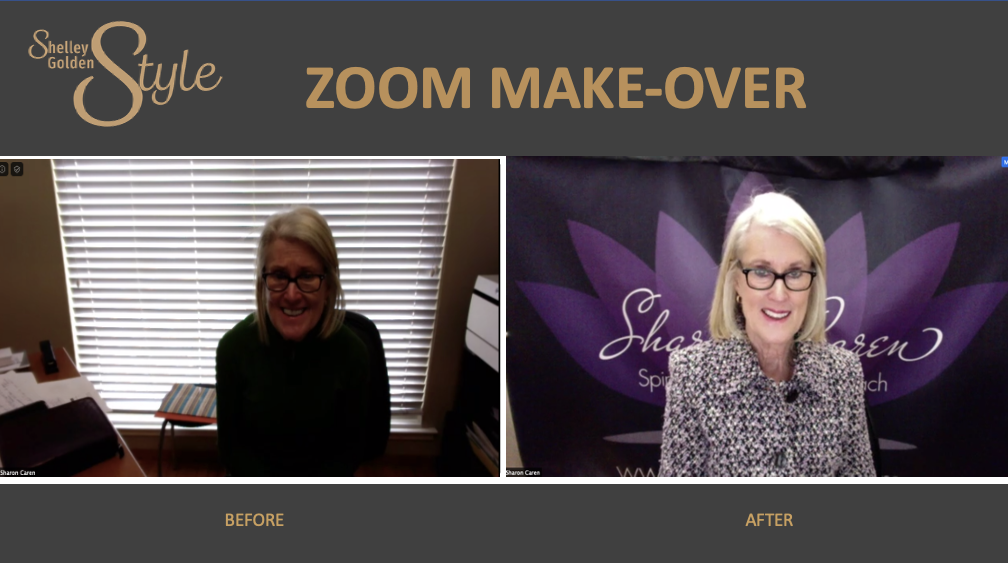This article originally appeared in the spring issue of the California Litigation Journal.
As Zoom trials and depositions continue to be conducted online during Covid and beyond, it’s critical to control how you, and everyone involved in the case, show up. Whether it’s you, your client, your deponents, or expert witnesses, each must come across as polished, credible and trustworthy.
It’s more important than ever to be intentional in aligning all the visual aspects in the Zoom box, which can make or break your court case.
Even if you are not a lawyer, the same rules apply.
As Zoom trials and depositions continue to be conducted online in this COVID era, it’s critical to control how you, and everyone involved in the case, show up. Whether it’s you, your client, your deponents, or expert witnesses, each must come across as polished, credible and trustworthy. Since people decide within 100 milliseconds whether to trust another person, according to the 2006 Princeton University study by Todorov and Willis, it’s important to be intentional in aligning all the visual aspects in the Zoom box, which can make or break your court case. Credibility is more challenging on Zoom since you usually don’t generally see one’s entire body, thus, making it more difficult to read the non-verbal cues. Your expert witness knows that opposing counsel is scrutinizing every behavior, comment, and gesture, and you’re paying them for their professionalism, not just their expertise. They may not be aware that being deposed on Zoom requires that they pay additional attention to how they show up. Your client and deponents may be even less aware that their background, lighting, camera angle and clothing can factor heavily into which way the case goes.
THE 5 ZOOM MAKEOVER STEPS TO INCREASE CREDIBILITY AND TRUSTWORTHINESS
To ensure each participant intentionally shows up the way you want them to, you can suggest they follow my 5-step process. Remember: video catches everything — it’s a permanent record of each person’s words, behaviors, and emotions. Understanding the principles underlying the steps will give you an even better chance to win your case. For participants who are nervous about appearing on video, these steps will act as a positive safety valve that helps to improve their confidence level. The burden is now on the individual.
1. Camera
Empirical research in many fields, such as film and education (virtual classrooms), generally conclude that the subject speakers were rated as most trustworthy when videoed from eye level and that low and high-camera angles were often associated with less trust. Set the camera just at eye level. Make sure to look directly into the camera. This shows the legal team feels you are looking and talking directly to them.
- Sit about three feet from the camera lens.
- Frame yourself so that your eyes are in the top one-third of the Zoom window.
- Leave a little bit of space above your head (also known as “headroom”). The bottom of the video window should be at armpit level.
2. Sound
- An external microphone such as a clip-on lavalier microphone or ear pods will improve how you sound and reduce background noise. If you don’t have an external microphone or headphones, use the built-in microphone on a laptop or phone. A word of caution: these microphones pick up background noise that can overpower what you’re saying.
- Check your video conferencing platform for the “noise suppression” option — it will allow you to adjust the suppressed background noise feature and put out your best possible voice audio.
- Stay on “mute” unless you are called on to speak.

©Shelley Golden
3. Lighting
Lighting is critical. It’s how other people in the Zoom room see you. Good lighting illuminates your eyes and face evenly, showing you at your best.
- If available, natural daylight can be the best, as it provides a soft light on your skin. Lighting is most effective when the light comes directly in front of you or from the sides.
- If the light source is coming from behind you, you’ll appear in silhouette, and other participants won’t be able to see you properly.
- If you wear glasses, and the possibility to sit facing a window isn’t an option, position two lights, one on each side of your face, angled toward you at 10 o’clock and 2 o’clock positions. If you have adjustable floor lights, position them higher than your head and angle them down. If you do not wear glasses, it’s OK to have the light source directly in front of you.
- Keep in mind the light bulb hue. Is it a warm color (has more yellow) or cool (has more white)? Purchase a light that allows you to adjust the color “temperature.” The color temperature for daylight is a cool, white 5600K —; incandescent lights produce a warmer, more yellow 3200K. (“K” stands for Kelvin, after Lord Kelvin, a scientist who among other inventions gave us the concept of color temperature). Test your lights by setting a mock video session so that you can determine which light positions and color temperature make you look your best.
TIP: I often suggest putting fuchsia and bright yellow Post-Its over part of your lights to create a pleasing skin tone.

©Shelley Golden
4. Background
What does your background say about you? Ensure you have a background without visual distractions such as messy papers or clothing scattered on furniture. If you have a plain, solid color wall, set your computer and lights up while sitting in front of the wall. Don’t wear the same color clothing as the background because your body will vanish into the background. Wear a contrasting color from your background. Dark furniture, walls and clothing absorb light, which can leave your face poorly lighted. Make sure family members, meandering furry pets and phone calls don’t interrupt you.
The Zoom virtual meeting app has several built-in settings that you can use to optimize your appearance:
- If you don’t have an ideal background, Zoom has a “blur” feature that you can click on in the “video filters” section of the “video settings.”
- I generally recommend against using a virtual background. These backgrounds distract, cause your face to vanish and appear repeatedly when you make certain movements, and cause paper to vanish and appear if you lift up a sheet. Most important: the wrong virtual background will send the wrong message about you. The blur feature isn’t considered a virtual background.
- If you determine you must have a digital background, purchase a green screen. A virtual image inserted over the screen will eliminate most of the visual distortions.
5. Dressing for a Video Deposition
First impressions matter and are usually based on your appearance. When you are giving a video deposition, everything the judge, jurors, and your adversary see on the video screen reflects on you and your credibility. The idea is to portray a positive image. You don’t want to turn the jury off or lose credibility. Part of what you want to convey during a video deposition is that you respect the process and that you are taking the matter seriously. By dressing conservatively, you show respect for the process and will be taken more seriously. Like it or not, trial judges and jurors consider what we wear in their determination of our credibility. Despite the virtual setting, it’s still important to dress as if you were standing in front of the judge in the courtroom, including below the waist. You want to be confident that everyone who sees your video deposition is focused on what you say, not how you look. Consider these important factors when selecting clothing and color:
- Colors: It’s best to wear solid colors in the middle range: blue, tan, green, gold, gray, and purple. Avoid wearing
- Dark colors—appear even darker online
- Red
- White—the camera unnaturally darkens your face
- Black—more difficult to read your body language
- Avoid wearing plaids, stripes, herringbone, or loud patterns—besides looking like jittering lines on the screen, they tend to make you appear at least ten pounds heavier.
- Avoid T-shirts and tank tops.
- Accessories: Avoid wearing glitzy and flashy jewelry, remove piercings that are not in your ears and wear clothing that covers tattoos.
- Makeup: Keep your makeup simple and minimal, including lighter and more natural colored lipstick and avoid shiny lip gloss.
- Neatly trim facial hair.
- Tie back long hair or comb it to be able to clearly see your face.
When you take control over how you, your clients, your deponents and expert witnesses show up on Zoom depositions and trials, you’ll ensure appearance doesn’t become an unnecessary distraction. Rather, it amplifies credibility and trustworthiness of everyone on the video conference call, positively adding to how the judge and the jury perceive you and your case. After all, in the “Zoom” era an old maxim holds steadfast: first impressions still matter.
Link to original article: https://publication.calawyers.org/spring-2022/litigation/




